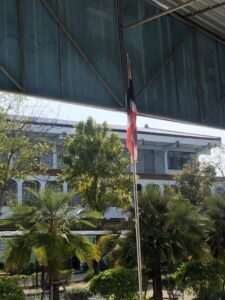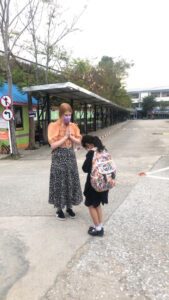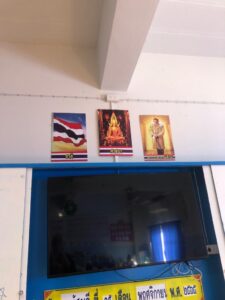By Arabella, ESL Kindergarten Teacher in Tak
One major difference I noticed between Thai and English schools was how I started every day – the assemblies! The morning routine in Thailand differs greatly from that of English schools, due to religion and traditions. This assemblies themselves can change slightly dependent on whether it is happening in kindergarten, primary or secondary schools in Thailand. I have only experienced the kindergarten assemblies of Thailand so far, but they have been quite eventful!
Firstly, after arriving at school (7.30am) and scanning our thumb print, we go into the Mini English Programme (MEP) office and eat breakfast/prepare for the day. This includes bringing in the children, hanging up their belongings and getting them stood in line ready for assembly at 8am on the dot. The children stand in their cohorts (Kindergarten 1, 2 or 3) and the teachers are very strict on the line being straight and looking neat.

The Thai flag after it has been raised in the morning assembly.
At 8am on the dot, there is the raising of the Thai flag whilst listening to the national anthem. All students must stand still for this, with their arms by their side and facing the flag. If someone is walking or doing something when the national anthem starts playing they must stop what they are doing, stand still and face the flag until the song is finished. For many weeks I listened to this without understanding the meaning, but after teaching a lesson on Thai culture, I have since learned the lyrics of the Thai national anthem:
The National Anthem of Thailand (Phleng Chat Thai)
Pra thet thai ruam luead nu’a chat chu’a thai
Pen pra cha rat pha thai kho’ng thai thuk suan
Yu dam rong khong wai dai thang muan
Duay thai luan mai rak sa mak khi
Thai ni rak sa ngop tae thu’ng rop mai khlat
Ek ka raj ja mai hai khrai khom khi
Sa la luead thuk yat pen chat p’hli
Tha loeng pra thet chat thai tha wi mi chai ch’yo
Thai National Anthem (translated to English)
Thailand embraces in its bosom all people of Thai blood.
Every inch of Thailand belongs to the Thais.
It has long maintained its sovereignty,
Because the Thais have always been united.
The Thai people are peace-loving,
But they are no cowards at war.
They shall allow no one to rob them of their independence,
Nor shall they suffer tyranny.
All Thais are ready to give up every drop of blood
For the nation’s safety, freedom and progress.
 After singing along to the Thai national anthem and the flag has been raised, the children and teachers bow (or ‘wai’) towards the flag and the assembly begins. Each morning a few children from a different classroom each day are chosen to lead the assembly with a teacher via a microphone. The next part of the assembly is conducted whilst all students and teachers are making a ‘wai’ gesture with their hands; it is a sign of respect and is central in Thai culture.
After singing along to the Thai national anthem and the flag has been raised, the children and teachers bow (or ‘wai’) towards the flag and the assembly begins. Each morning a few children from a different classroom each day are chosen to lead the assembly with a teacher via a microphone. The next part of the assembly is conducted whilst all students and teachers are making a ‘wai’ gesture with their hands; it is a sign of respect and is central in Thai culture.
This can include the next part of the assembly, which is a three-step Buddhist prayer about respect and good luck for life. First, there is a pray for the Buddha, then for the monks and finally there is a prayer for our personal lives. There is then the mantra of being kind to others, helping others and giving love to other people. This is repeated three times. Traditionally, the most important things to Thai people are their nation, their King and their religion – this is what the colours of the Thai flag represent (red – nation, King – blue, white – religion) and there are pictures of all three in most if not all Thai classrooms.
Then the students say good morning and thank their fellow students (once for boys, who they call ‘brothers’ and once for girls, who they call ‘sisters’). Then teachers go to stand at the front of the line and the children say good morning to their teachers and thank them. All children then sit down in their lines and listen to a meditation song. This song translates to ‘Like A Blooming Flower’ and is a breathing and movement exercise aiming to relax the children in preparation for the day:

The three main components of traditional Thai culture and what the Thai flag is based on – nation, religion and King.
Like A Blooming Flower
“I’m breathing in, I’m breathing out. As flowers bloom.
The mountains high, the rivers sigh.
The air that I breathe, I fly.” x4
After this, there are the usual assembly announcements, such as forecast rain so wear coats, remember to not run in school, wash your hands before lunch and after using the bathroom, etc. After this there is dancing before classes start – generally the children will dance along to three songs (copying the teachers for the moves). Over the weeks, these songs have included ‘The Cha Cha Slide’, ‘Salamander Dance-Freeze Song’, ‘Baby Shark’, ‘If You’re Happy & You Know It’, plus some Thai songs that the children all know the dance moves too but the foreign teachers don’t! Then all students thank the teacher leading the assembly ‘khob khun kha / khrub’ then go to the restroom before classes start.
Very popular dance song for children in Thai kindergarten ‘Dance-Freeze’
Having been educated in England in a non-religious school, at the beginning it felt odd to stand for a national anthem that was not my own and prayer for a religion I did not follow. However, living in the kingdom of Thailand, it is important to follow their customs and traditions to assimilate into the culture. This was appreciated by the other teachers and set a good example for the children. And now dancing with the children is one of the favourite parts of my morning!
Assemblies in England generally involved gathering the whole school together in a big hall and were for presenting information or events to students and staff. And in some religious schools there would also be a common prayer or song. There was no dancing, no thanking students/teachers, and no national anthem playing whilst raising the national flag, so this has been an interesting and insightful cultural switch to experience.
Ready to start your teaching adventure in Thailand? Explore our program page or submit an application




